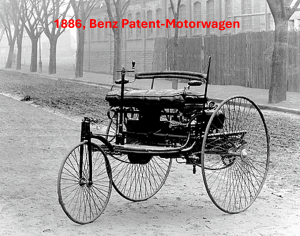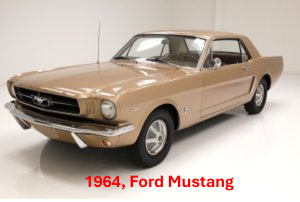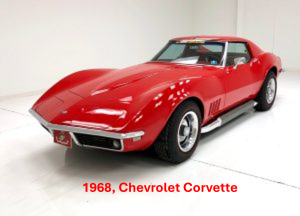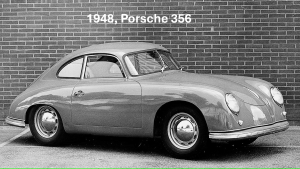Significant Developments in the Automotive Industry
From the beginning to the 1990s – part 1
The automotive industry has evolved over a century, from the earliest horseless carriages to today’s sophisticated, high-tech vehicles. Below is a detailed description of the key milestones in the history of car manufacturing with interesting stories of the people behind them.
- The Invention of the Automobile (Late 19th Century)
It was Karl Benz who built the first practical motorcar in 1886. The Benz Patent-Motorwagen is often considered the first true automobile, powered by a single-cylinder four-stroke engine. This milestone was the foundation of the Mercedes-Benz brand, one of the oldest and most prestigious car manufacturers.
What Benz achieved was unique, however, his journey to creating the first car was not an easy ride. People could not imagine a future where automobiles would replace horses or become a mainstream mode of transportation. Moreover, many considered the idea of a motorcar unrealistic, if not downright dangerous. To make matters worse, Benz had to face rejection from investors and colleagues who were uncertain about the practicality of his invention. Benz could do nothing but trust in his abilities and continue his work, relying only on his own resources, which ultimately led to success.

- Mass Production and Assembly Line (Early 20th Century)
In 1913, Henry Ford revolutionized the automotive industry by introducing the moving assembly line for mass production at the Ford Motor Company’s plant in Michigan. This innovation drastically reduced the cost of car production and made automobiles more affordable to the general public. The Model T Ford, launched in 1908, is recognized for having made automobiles widely available.
What exactly did Ford do besides designing and manufacturing a great car? In 1914, Ford raised daily wages from $2.34 to $5, and thousands of people applied for jobs at the car factories. The interest was so high that a near-riot broke out due to rejections. Of course, Ford did not raise wages out of his philanthropic character, but because a well-paid worker would be able to afford to buy the cars he produced. This is also why he introduced the five-day workweek. The worker would be more rested, have more money, more time to spend, and would end up buying the car as well.
- Introduction of V8 Engines (1930s)
The Ford V8 engine, introduced in 1932, was a major leap forward in car performance. It provided a much more powerful and smoother driving experience than the previous 4-cylinder engines. This engine became iconic in American car culture, and Ford’s leadership in producing affordable, powerful cars solidified their position in the market.
The V8 engine quickly gained a reputation for speed and power, and it didn’t take long before it became a popular choice for racing enthusiasts. The Ford V8 engine earned a legendary status among the outlaws of the 1930s as well, including infamous figures like Bonnie and Clyde. Their criminal activities, often involving high-speed getaways, were famously aided by the performance of the Ford V8. The engine’s power made it possible to outrun the police, cementing the V8’s place in American pop culture.
- The Birth of the First Sports Car (Late 1940s)
The Porsche 356, designed by Ferry Porsche in 1948, is often regarded as the first true sports car, combining performance and style. This was the start of Porsche’s legacy as a manufacturer of high-performance vehicles.
An interesting aspect of the 356’s development story is Ferry Porsche’s determination to make his vision a reality, even in the face of financial uncertainty and skepticism. He was quoted as saying: “If you want to build a sports car, then build it. Don’t just talk about it.”
This attitude was characteristic of Ferry Porsche, who was determined to not just follow the conventional path but to create something new and exciting.
- The Introduction of the Unibody Construction and safety innovations (1950s)
In the 1950s, Chrysler introduced unibody construction, where the body and chassis of the car were integrated into a single piece. This design reduced weight and improved fuel efficiency, becoming the standard for future automobile manufacturing.
In the 1950s, Seat belts and crumple zones are introduced, making automobiles safer. Power steering and automatic transmissions are also popularized.
The 1959 Volvo PV544, which included the three-point seatbelt created by Swedish engineer Nils Bohlin at Volvo, was the first vehicle to have a seatbelt installed as standard equipment. Later, Volvo made the patent for the three-point seatbelt available to all automakers for free, promoting safety as a priority across the industry.
- The Popularization of Compact Cars (1960s)
In the 1960s, the growing need for fuel-efficient, smaller vehicles led to the rise of compact cars. Brands like Volkswagen, with its iconic Volkswagen Beetle, and Ford with the Ford Mustang, popularized affordable, small vehicles that appealed to urban consumers and a younger generation.
One of the most interesting aspects of the Mustang’s story is its immediate success. When the Mustang hit the market on April 17, 1964, it was an instant hit. Ford had projected they would sell 100,000 units in the first year. However, by the end of 1964, they had sold over 400,000 units. This success helped to define an entirely new class of car: the pony car, which combined performance and style at an affordable price.

The Volkswagen Beetle was an icon of the hippie generation, particularly after its appearance in the famous 1968 movie “The Love Bug,” which showcased a magical, self-driving Beetle named Herbie.
- The Introduction of Fuel Injection (1970s)
The fuel injection system, developed by Bosch and adopted by brands like Mercedes-Benz, replaced carburetors and improved engine efficiency, performance, and fuel economy. This development was crucial as fuel economy became a priority during the oil crises of the 1970s.
One of the first cars with electronic fuel injection was the 1968 Chevrolet Corvette. Compared to the previous mechanical systems, EFI offered even better performance, fuel economy, and emissions control by precisely controlling the fuel-air mixture.

- The Development of Hybrid Vehicles (1990s)
The Toyota Prius, launched in 1997, was the world’s first mass-produced hybrid car. It combined an internal combustion engine with an electric motor, significantly improving fuel efficiency and reducing emissions. Toyota became a pioneer in eco-friendly automobiles thanks to its leadership in hybrid technology.
It was Toyota who introduced the JIT (Just-in-Time) production system which had a huge impact on the quality of automobile manufacturing. According to the JIT principle, the manufacturer orders only as many parts as are needed for production, thereby reducing inventory management costs and the likelihood of errors.

Part 2 of this article will discuss automotive developments from the early 2000s to the present day, and will also present the future of automobile manufacturing. We will examine where further automotive advancements will take us.








